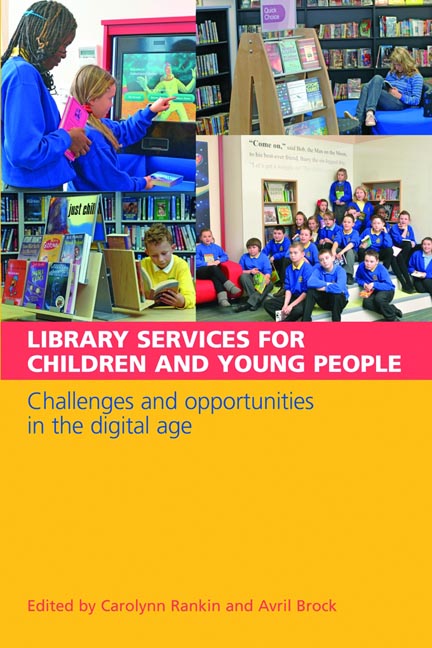Book contents
- Frontmatter
- Dedication
- Contents
- Contributors
- Foreword
- Acknowledgements
- Introduction and vision for the book
- Part 1 Children's library services – policy, people and partnerships
- Part 2 Connecting and engaging – reaching your audience and catching the latest wave
- 5 Libraries, literacy and popular culture – let's get reading!
- 6 Libraries, literacy and popular culture – what's cool to read?
- 7 Creative integration of information technology in the school library
- 8 Comics, manga and graphic novels – developing, selecting and promoting a core collection for teenagers and young people
- 9 Connecting and engaging with children and young people – the Australian public library perspective on outreach and marketing
- 10 Case study. Partnerships and library outreach in the National Year of Reading 2008
- Part 3 Buildings, design and spaces – libraries for children and young people
- Part 4 Issues for professional practice
- Index
6 - Libraries, literacy and popular culture – what's cool to read?
from Part 2 - Connecting and engaging – reaching your audience and catching the latest wave
Published online by Cambridge University Press: 08 June 2018
- Frontmatter
- Dedication
- Contents
- Contributors
- Foreword
- Acknowledgements
- Introduction and vision for the book
- Part 1 Children's library services – policy, people and partnerships
- Part 2 Connecting and engaging – reaching your audience and catching the latest wave
- 5 Libraries, literacy and popular culture – let's get reading!
- 6 Libraries, literacy and popular culture – what's cool to read?
- 7 Creative integration of information technology in the school library
- 8 Comics, manga and graphic novels – developing, selecting and promoting a core collection for teenagers and young people
- 9 Connecting and engaging with children and young people – the Australian public library perspective on outreach and marketing
- 10 Case study. Partnerships and library outreach in the National Year of Reading 2008
- Part 3 Buildings, design and spaces – libraries for children and young people
- Part 4 Issues for professional practice
- Index
Summary
Introduction
In this chapter we explore how children can be encouraged to develop a varied diet of reading, through reference to strategies, research findings and the perspectives of children, themselves, on what they think is cool to read. The first half of the chapter looks at the value of diverse texts and discusses what benefits emerge from reading a range of genres. The second half of the chapter looks closely at strategies and factors that influence a child's reading choices.
Why is a range of genres important?
Reading a variety of categories, compositions or styles of writing, in different kinds of literary texts, is important for readers to gain a balanced diet of reading materials. The child's introduction to a range of genres is important, in order to help develop knowledge and wider life experiences through fiction and nonfiction texts, as well as building upon personal, individual interests and experiences. A snapshot of the range of genres available involve stories, books and information texts that include adventure and mystery, science fact and science fiction, historical fact and fiction, contemporary crime fiction, dilemma stories, romance and gothic tales, plays and dialogues, poetry and rhyme, myths, legends, fairy tales, fables and traditional tales, and the media, news and popular culture. Teachers and librarians should provide children with reading experiences by encouraging them to access as many of the genres listed above as possible. For example, if children read and explore traditional tales it encourages them to think about dealing with the big issues in life, such as: Who are we? Where do we come from? How do we deal with life's troubles and difficulties? How should we behave? What is the truth? What is our place in the big picture of things? Cultural beliefs, values or messages can be underlying themes of a traditional tale. Young readers can explore life themes and inner conflicts through literature and, in this way, critical thinking, philosophical discussion and moral decision-making can be developed.
Favourite books, classic tales and historical experiencing
Literature is a powerful medium for communicating ideas, transmitting emotions and finding out about other people's culture, language, religion and life experiences. Meek's (2001) work explores these issues, in her classic text Children's Literature and National Identity.
- Type
- Chapter
- Information
- Library Services for Children and Young PeopleChallenges and opportunities in the digital age, pp. 89 - 108Publisher: FacetPrint publication year: 2012

